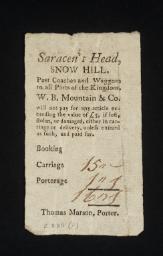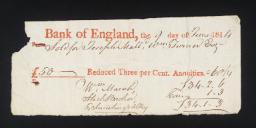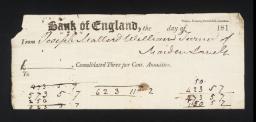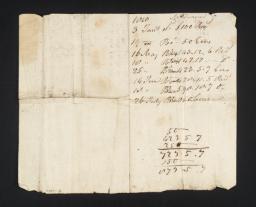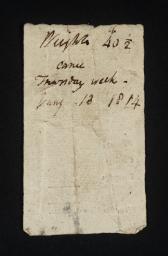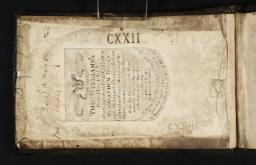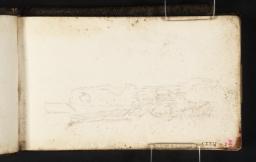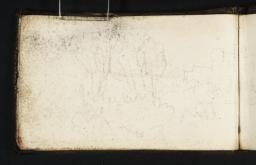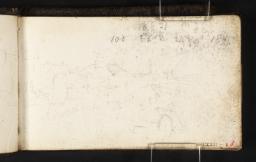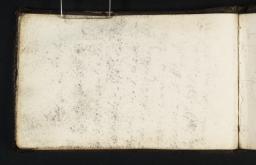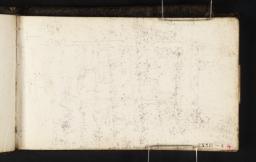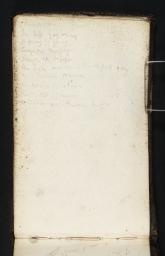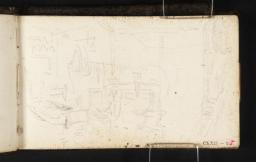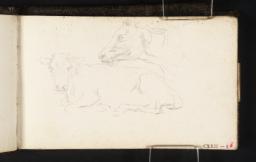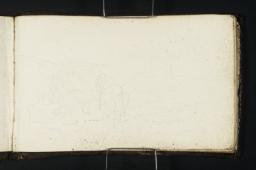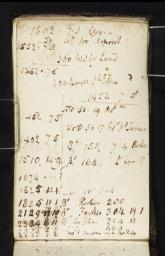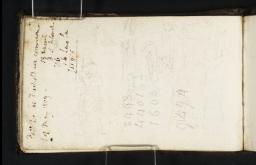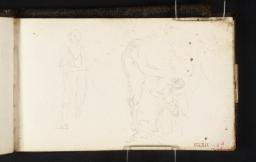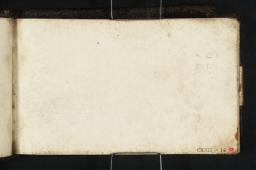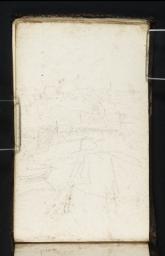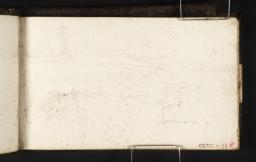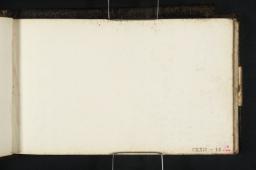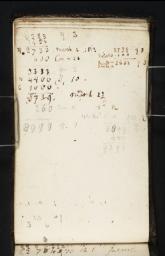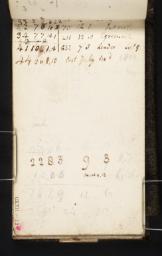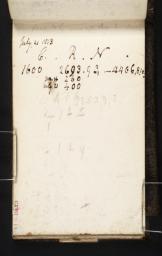Turner Bequest CXXII 1–44a and (1)–(4)
Sketchbook bound in boards, covered in black leather with blind-stamped double line around all edges of front and back covers and brass mounting for a clasp surviving on back cover only; inside front cover (D40898) constructed to form a pocket and upper overlap of back cover extended to form a pencil holder
44 leaves and endpapers of white wove paper; various sheets watermarked ‘E & P | 1801’; page size 69 x 112 mm
Made by Robert Edmeads and John Pine, Ivy Mill, Maidstone, Kent; supplied by Thomas Williams, London (label inside front cover, D40898)
Neither numbered as part of the Turner Schedule in 1854 nor endorsed by the Executors of the Turner Bequest
44 leaves and endpapers of white wove paper; various sheets watermarked ‘E & P | 1801’; page size 69 x 112 mm
Made by Robert Edmeads and John Pine, Ivy Mill, Maidstone, Kent; supplied by Thomas Williams, London (label inside front cover, D40898)
Neither numbered as part of the Turner Schedule in 1854 nor endorsed by the Executors of the Turner Bequest
Accepted by the nation as part of the Turner Bequest 1856
References
A note on the subject categories of Turner’s Liber Studiorum landscape engravings appears on folio 25 recto (D08321). Its presence in this otherwise very miscellaneous sketch- and notebook has determined the book’s positioning in this catalogue within a grouping of Liber-related material. The note’s significance is discussed in the context of the Liber’s scope and categorisation in the present author’s overall Introduction to the separate ‘Liber Studiorum c.1806–24’ section.
The extensive accounts and calculations which prompted this sketchbook’s longstanding name are inside the front cover (D40898), on folios 3 recto, 7 verso, 8 recto and verso, 12 verso, 13 recto and verso, 14 recto and verso, 15 recto, 20 recto, 36 recto and 44 verso (D08286, D08294–D08296, D08302–D08307, D08313, D08340, D08355), and inside the back cover (D40901). In addition, uniquely in the Turner Bequest, there is a bundle of four loose papers in the integral pocket inside the front cover (D40898). One, D08356 (Turner Bequest CXXII (1)), is a receipt from a London coaching inn, with a delivery note on the back (D40899). Two others (D08357, D08358; Turner Bequest CXXII (2), (3)) are pre-printed Bank of England slips with manuscript additions. A fourth is a much-folded sheet of accounts (D08359, D40900; Turner Bequest CXXII (4) and verso). On the last of these the Liber Studiorum is mentioned again.
Finberg assumed the list of picture prices on folio 36 recto (D08340) was drawn up in 1810, at a time when Turner had long-term commitments to London properties in Harley Street and the adjacent Queen Anne Street West, including his own gallery, so he needed to see ‘what other assets he possessed’;1 see also the list of about the same date on D40900. As John Gage has observed, Turner’s income came to be ‘derived as much from investments as it was from art’, and he began to accumulate stock in the Government Funds in the late 1790s, often making notes of these transactions and holdings in his sketchbooks; by 1810 these investments amounted to thousands of pounds, and Turner customarily used payments from pictures to increase his portfolio.2 As is made clear from Finberg’s analysis of some of the figures (see under D40900), Turner’s customary abbreviations ‘C’, ‘R’ and ‘N’ stand for Consolidated (or ‘Consol’), Reduced and Navy annuity stocks. Nicholas Powell notes that at his death his Funds holdings were valued at £70,000.3 He also built up a small but varied portfolio of property and land scattered around London and the Home Counties.4 Turner did not have a bank account, but (in the early 1810s at least) invested his money through a stockbroker, William Marsh, of 5 Sweeting’s Alley in the City of London (see D08357; Turner Bequest CXXIII (2)), cashing in his stock when necessary.5
Turner concluded that he was worth something like £12–13,000 around 1810, Finberg noted,6 ‘so that if he decided to spend £1,200 on his gallery and house in Queen Ann[e] Street, and another £500 on a House at Twickenham [see the ‘Sandycombe Lodge c.1808–12’ section of this catalogue], he could afford to do so without much risk of ruining himself’;7 for the ‘500’ and ‘1200’ figures and a more detailed discussion of Turner’s total, see D40900 (Turner Bequest CXXII (4) [verso]). James Hamilton puts Turner’s ‘attention to detail’ in the notes here down to ‘having earned every penny he owned’.8 Often the figures in this sketchbook are directly comparable with those in similar accounts in the Hastings sketchbook, in use around 1809–14 (Tate; Turner Bequest CXI). The latter has been catalogued here by David Blayney Brown in the ‘East Sussex c.1806–20’ section, and cross-references are made in the individual entries in the present book, as well as between individual pages here.
Other inscriptions in this sketchbook are drafts of poetry, or what appears to be poetry, on folios 3 verso, 4 verso and 24 recto (D08287, D08289, D08319), and memoranda including names and addresses and notes on Hinduism, which appear on folios 13 verso, 35 verso, 39 recto, 40 recto, 41 recto, 42 recto, and 44 recto and verso (D08304, D08339, D08345, D08346, D08348, D08350, D08354, D08355).
Sketches are interspersed among the notes. Some are concerned with rural themes: studies on folios 4 recto, 5 recto, 8 recto and verso and 9 recto (D08288, D08290, D08295, D08296, D08297) can be related to the painting A Country Blacksmith Disputing upon the Price of Iron, and the Price Charged to the Butcher for Shoeing his Poney, exhibited at the Royal Academy in 1807 (Tate N00478),9 while there are sketches of cattle on folios 6 recto and 7 recto (D08291, D08293).
A sequence of identified and unidentified landscapes, mostly drawn inverted on page versos, suggest that Turner worked inwards from the back of the sketchbook as now foliated, travelling along and in the vicinity of the River Thames between central London and Berkshire. The river was a frequent source of inspiration to Turner, particularly in the decade from the mid-1800s onwards (see David Blayney Brown’s section on ‘Thames sketchbooks c.1804–14’ in the present catalogue).10 The identified or likely subjects, moving up-river, are: London Bridge (folios 34 verso–35 recto; D08337, D08338); Syon House, Isleworth (folio 41 verso; D08349), with which a sketch of swans might be associated (folio 43 verso; D08353); Henley-on-Thames (folios 6 verso, 20 verso; D08292, D08314); and Reading (folios 24 verso–25 recto, 25 verso, 26 verso, 27 recto and 31 verso; D08320, D08321, D08322, D08324, D08325, D08332).
Together with these are more generic studies of boats, canal locks, bridges and other buildings and wooded landscapes suggesting the Thames Valley: folios 2 recto, 2 verso–3 recto, 10 recto and verso, 11 recto, 16 recto, 18 verso, 23 verso, 29 verso, 30 verso, 34 verso, 35 verso, 36 verso, 37 verso, 40 verso, 42 verso and 44 verso (D08284, D08285, D08286, D08298, D08299, D08300, D08308, D08311, D08318, D41431, D08330, D08336, D08339, D08341, D08343, D08347, D08351, D08355). There are also a few cloud studies, on folios 27 verso–28 recto, 32 recto, 33 recto and 33 verso (D08326, D08327, D08333–D08335).
Ian Warrell has noted that this is one of the five sketchbooks containing erotic drawings which were, deliberately or accidentally, among eleven sketchbooks not recorded and endorsed in the inventories of the Bequest made in 1854 and 1856; the single drawing in question in this case is on folio 37 recto (D08342). However, it is possible that the presence of so many pages of inscriptions as opposed to sketches in general caused the book to be deliberately excluded.11
Two leaves are watermarked ‘[18]01’ (see the Technical notes); as Martin Butlin and Evelyn Joll have observed, the sketchbook ‘contains notes dated 1809, 1810, 1812, 1813 and 1814’.12 The latter date and the sketches relating to the 1807 painting mentioned above have provided the range of about 1807–14 assigned here to the sketchbook as a whole, and to individual pages when more specific evidence is lacking. It is possible that ‘1805’ is written inside the back cover (D40901), but the reading and the date’s significance are unclear, and it has been disregarded for dating purposes, although it is of course possible that the Country Blacksmith studies could pre-date the painting by several years.
The author would like to acknowledge the value of Eric Shanes’s unpublished review of the financial matters raised by the inscriptions in this sketchbook within the context of Turner’s career around 1810.13
Finberg 1961, p.171; see also James Hamilton, ‘Harley Street’ and ‘Queen Anne Street West’, and Luke Herrmann, ‘Turner’s Gallery and Exhibitions’ in Joll, Butlin and Herrmann 2001, pp.135, [252] and 349–50 respectively.
Gage 1987, pp.171, 252 note 35 (the latter mentioning the separate financial documents associated with this sketchbook).
See also David Hill, Turner on the Thames: River Journeys in the Year 1805, New Haven and London 1993.
Technical notes
How to cite
Matthew Imms, ‘Finance Sketchbook c.1807–14’, sketchbook, September 2013, in David Blayney Brown (ed.), J.M.W. Turner: Sketchbooks, Drawings and Watercolours, Tate Research Publication, September 2014, https://www

